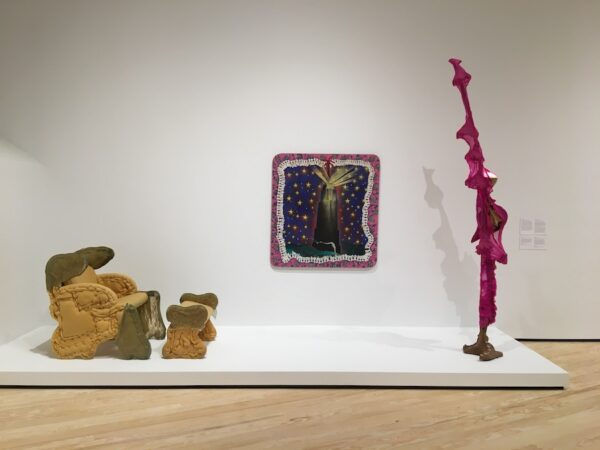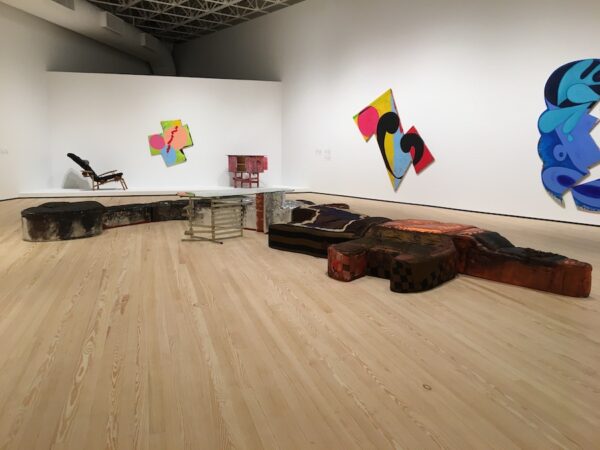
Installation view of “Wild Life: Elizabeth Murray & Jessi Reaves” at Contemporary Art Museum Houston, 2021. Photo by author.
Now that we (well, at least those of us in the art world) are firmly removed from postmodernism’s paradigmatic grip, we can safely say that we are in the midst of a not-yet-named period in which we are reexamining history and the problematic — not to mention myopic — ways in which it has been told. Because of this, we are seeing more exhibitions that think through, if not outright challenge, those very problems by revisiting an art historical dialogue through a contemporary lens.
With the exhibition Wild Life: Elizabeth Murray & Jessi Reaves at Contemporary Arts Museum Houston, CAMH curator Rebecca Matalon’s approach to rethinking and re-categorizing our splintered histories is by instituting a cross-generational dialogue of two women artists: Elizabeth Murray and Jessi Reaves. The late Murray, the elder of the two, was a renowned and critically acclaimed artist in her lifetime, but Matalon’s argument here is that the feminist implications surrounding her work, specifically in relation to the banal and the domestic, remain under-examined. Matalon’s attempt at reifying the feminist critical dialogue surrounding Murray’s work into the art historical canon is to pair it with the work of contemporary sculptor Jessi Reaves.
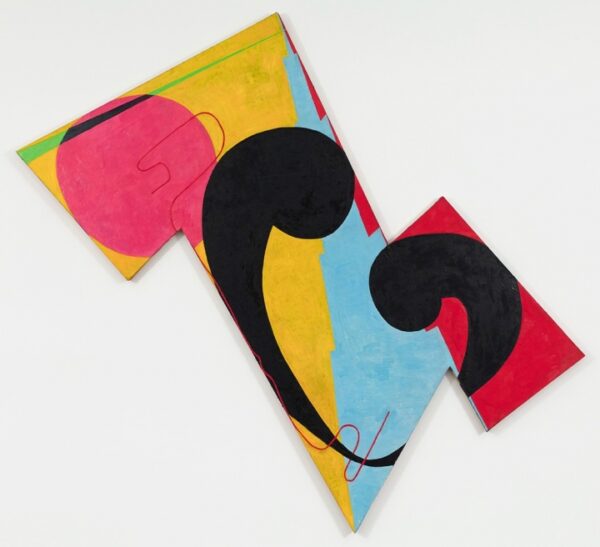
Elizabeth Murray, C Painting, 1980-81. Oil on canvas. 109 x 114 inches. Collection Eleanor and Bobby Cayre, New York, New York. ©2020 The Murray-Holman Family Trust / Artists Rights Society (ARS), New York.
In theory, I think cross-generational pairings like this are a great way to for us to re-examine older contemporary work, to provide more context for it, and to more clearly lay some groundwork to make the argument that we should reexamine this artists’ work, especially from a more current paradigm. And I believe Matalon’s thesis has merit; this conversation around Murray’s work is fruitful. But Wild Life, instead of letting Murray’s work breathe, is relegating it to an Ikea-esque tableau.

Jessi Reaves, Twice Is Not Enough (Red to Green Chair), 2016. Wood, sawdust, steel, foam, silk, leather, and cotton, 39 x 28 x 32 inches. Collection Hope Atherton and Gavin Brown, New York, New York.
This show should work. Both Murray and Reaves’ work is irreverent and, at times, brash. The cross-generational approach is often an exciting, if not endearing way to freshly encounter older work and present newer work in an art historical context. Why doesn’t Wild Life cut it? I think there are moments of curatorial heavy-handedness, and that the commonalities between Murray and Reaves’ work is more circumstantial than Matalon acknowledges.
To be clear, the individual works in Wild Life are great. The show is worth seeing. Reaves’ voluptuous, odd furniture is worthy of Matalon’s critical examination. Most of it is corporeal, and delightfully and playfully ugly. The polyurethane foam in Idol of the Hares and Twice Is Not Enough (Red to Green Chair) protrudes and undulates like joyful, unapologetic bodies, and asks us to consider these as figurative sculptures — as more than functional pieces of furniture. A standout work in the show, based off of the architectural guidelines of CAMH’S main gallery, Silver Pitfall Ottoman [pictured in the installation photo at the top of this review], reads as comically and vaguely sinister, like a sacrificial platform for a strange strip-mall cult.
But there is a meta-conversation happening within Reaves’ work that may not make her the best candidate for the kind of cross-conversational pairing Matalon reaches for. Wild Life places work within work, as with Reaves’ Melted Natural inside of Silver Pitfall Ottoman, and it feels forced. And Reaves’ deliciously grotesque sectional, also called Silver Pitfall Ottoman, reads as much as a mountainesque landscape painting as it does an irreverent exercise in bad taste; her work bounces between play and narrative-driven posturing, and there’s a lot of introspective chatter that needs room to talk. It’s not that Reaves’ work can’t find a suitable partner. It’s that in CAMH’s space, Reaves’ and Murray’s work talk over each other, or, at times, even stifle each other into silence.
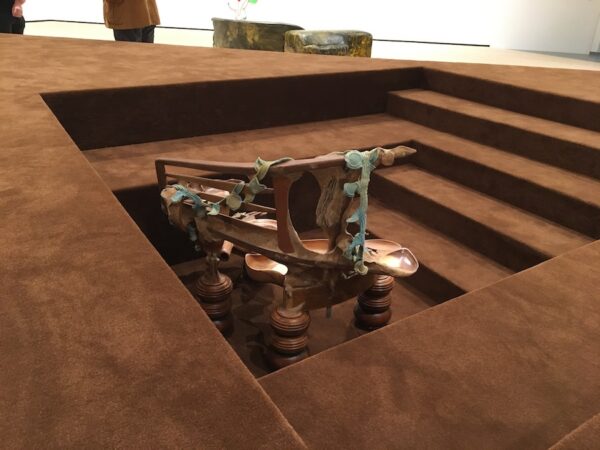
Jessi Reaves, European yellow couch, 2018. Vinyl, leather, jersey fabric, and paint. Courtesy of the artist and Bridget Donahue, New York, NY.
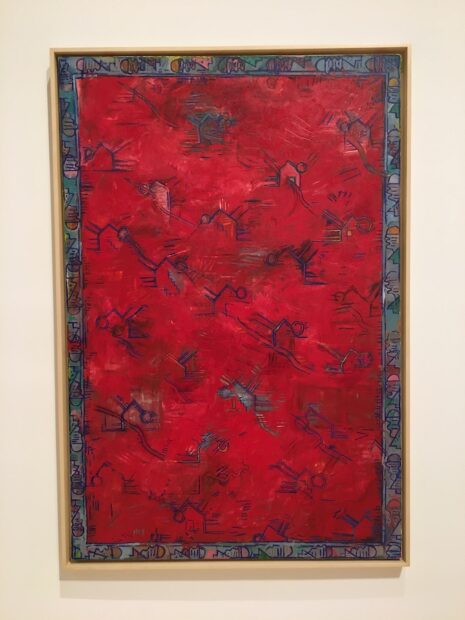
Elizabeth Murray, Dakota’s Red, 1971. Oil on canvas. Collection of Dr. and Mrs. Marvin Rappaport. Photo by author.
While the core of Reaves’ work is that of formal shapeshifting and storytelling, Murray’s is fundamentally conceptual. The squirrelly, intelligent, elusive manner in which she refuses categorization — highlighted by pieces like Dakota’s Red — should be discussed in feminist terms, because the way she uses the domestic sphere as an evasion technique is feminist. And Matalon’s position that this needs to be discussed is spot on. But Wild Life pins Murray’s work down into a kind of interior-design tableau. I feel that Wild Life veers into treating Reaves’ and Murray’s work (and the relationship between them) as sets of domestic props whose theatric curation undercuts the feminist argument it’s trying to make in the first place.
Through May 16 at the Contemporary Arts Museum Houston.


